Earth and Planetary Systems
Primary Faculty: Banerjee, Flemming, Longstaffe, Moser, Neish, Osinski, Secco, Shieh, Shuster
Our research focuses on understanding planetary surface and interior processes and their evolution through time, and astrobiology – the origin of life on Earth the search for life elsewhere. We focus on synthesizing micro- to macro- investigations, on pure and applied topics, with an emphasis on interdisciplinary collaborations and international partnerships.
Many of our researchers are active members of the Institute for Earth and Space Exploration and the Canadian Lunar Research Network (CLRN), a national group partnered with NASA. We also partner with national and provincial geological survey research programs (e.g., Geological Survey of Canada) to better elucidate lithosphere evolution.Our group of several faculty members focus on 3 major sub-themes – planetary surface processes, planetary interiors, and astrobiology/geomicrobiology – with cross cutting investigations utilizing planetary and terrestrial analogue (both natural and experimentally-generated) materials, fieldwork at analogue sites, and cutting-edge analytical and geochronological techniques.
Planetary Surface Processes
The surfaces of the terrestrial planets and rocky and icy moons of the outer solar system are shaped by numerous surface processes, from impact cratering and volcanism to glacial and fluvial erosion. Not all of these processes act to shape all planetary surfaces and the presence or absence of particular processes can tell us a lot about the origin, evolution and potential for life on a particular planetary object.
Impact processes
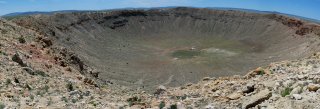
Impact cratering is a fundamental geological process that affects all planetary bodies with a solid surface. On many planetary objects, such as the Moon, Mercury, and much of Mars, meteorite impact craters are the dominant landform. The impact flux in the inner solar system is such that this was also the case during the early history of Earth.
Research in the Department of Earth Sciences focuses on understanding many aspects of the impact cratering process, including the tectonics of crater formation, shock melting and metamorphism, impact ejecta emplacement, and post-impact hydrothermal activity.
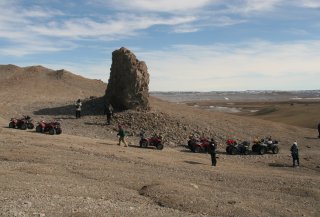
Specific ongoing projects include:
- Comparative studies of shock effects in lunar meteorites and terrestrial crater materials (Flemming, Moser, Osinski, Shieh).
- The origin and development of impact-hydrothermal systems (Banerjee, Osinski).
- Quantification of shock effects in meteorites and terrestrial materials using XRD, optical microscopy, IR, reflectance, and raman spectroscopy (Flemming, Osinski, Shieh).
- The effects of shock on accessory phases used in geochronology (Moser, Osinski, Shieh).
- Impact ejecta emplacement processes (Osinski, Neish).
- Tracking impact melt sources, timing and processes using accessory minerals (Moser).
- Records of past impacts in the detrital mineral record (Moser).
- Weathering and degradation of impact craters (Neish).
Glacial and periglacial activity
Mars is the most Earth-like planet in the Solar System. Mars today is a cold, dry environment and the entire planet comprises permafrost in the upper tens to thousands of metres of the crust. Significant deposits of ground ice and potential buried glaciers are also thought to occur. Through the comparative study of imagery from various spacecraft missions and studies of terrestrial analogue environments in the Canadian Arctic, researchers from the Department of Earth Sciences, in collaboration with the Department of Geography, are furthering our understanding of the glacial and periglacial processes shaping the Red Planet.
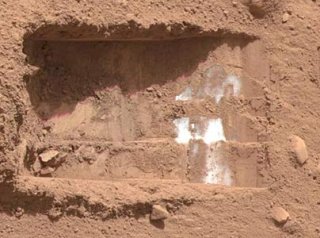
Specific ongoing projects include:
- Mapping of periglacial and glacial landforms in Utopia Planitia in the northern plains of Mars (Osinski).
- Ground-penetrating radar and lidar studies of periglacial landforms in the Canadian Arctic (Osinski).
Mineralogy and Geochemistry of Meteorites
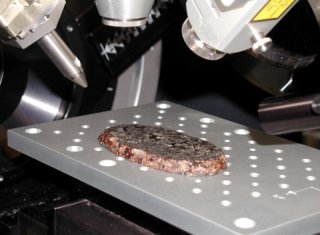
The Department of Earth Sciences is home to a growing astromaterials collection with several faculty involved in studies of meteorites. One of the most famous is the Tagish Lake carbonaceous chondrite (C2 ungrouped), which fell on Tagish Lake in BC in January 2000. This is the most primitive planetary material to have landed on Earth. Dr. Peter Brown at Western, together with Dr, Alan Hildebrand at University of Calgary, recovered 10 kg of material from the frozen Tagish Lake in spring 2000. The fall and recovery of this material is documented here. This material has been studied by numerous researchers at Western, and the investigation is ongoing.
Current research projects include:
- Understanding alteration processes in the Tagish Lake Carbonaceous Chondrite (Brown, Flemming, Longstaffe, Moser).
- Classification of unknown meteorites from the collection of Western alumni David Gregory (Flemming, Osinski).
- Weathering in meteorites (Flemming).
- Quantification of shock stage of meteorites (Flemming, Banerjee).
- Geochemistry and chronology of meteorites and planetary materials (Bouvier).
Planetary Interiors
We conduct direct research on rare samples of the subsurface and deep lithosphere as well as experimental research under conditions extending down to the Earth’s core in order to unravel the evolution and properties of the Earth system and other planets at their deep levels.
Experimental Studies
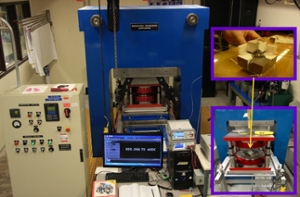
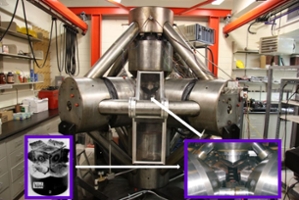
Studies of the deep interior of Earth and other planets are carried out in experimental laboratories in which very high pressures and temperatures are generated in order to replicate planetary interior environments. The main goals are to understand the physico-chemical behavior of silicates, oxides and metals with compositions relevant to the mantle and core under extreme pressure-temperature conditions. The results are applied to understanding the dynamic processes of mass and heat transport in the interior which controls the evolution of the both interior and surfaces of planetary bodies.
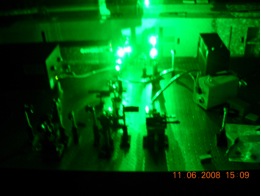
Recent and current research:
- Equation of State of Core-Mimetic Liquid Fe Alloys (Secco)
- Heat Conduction in Planetary Cores (Secco)
- Rheology of Liquid Metal Cores (Secco)
- Light Element Composition of the Outer Core (Secco)
- Radioactive Heating in the Core (Secco)
- Structure, elasticity and equation of state of lower mantle and core-mantle boundary (Shieh)
- Volatile materials (H, C and S) at deep mantle conditions (Shieh)
- Strength of silicates, oxides and metal at high pressure and high temperature (Shieh)
- Electronic structure of planetary materials at high pressure and high temperature (Shieh)
- X-ray diffraction and Raman study on ABO4 compounds at high pressures (Shieh)
- High-pressure and high-temperature studies on garnets and carbonates (Shieh)
- Nano-materials study under high pressure and temperature (Shieh)
Upper Mantle Mineralogy and Geochemistry
This research focuses on expanding our fundamental understanding of mineral behaviour and using minerals as interpretive and predictive tools in the context of Earth and planetary sciences. Minerals are the primary recorders of information in rocks. They record the conditions under which they have formed, including temperature (T), pressure (P), composition (X), redox conditions, and time.
Specific projects include:
- Synthetic analogue Earth materials: Fundamental understanding of mineral behaviour (Flemming).
- Quantifying short-range ordering in aluminous pyroxenes by 29Si MAS NMR spectroscopy (Flemming).
- Observation of both tetrahedral and octahedral Al by 27Al MQ MAS NMR Spectroscopy (Flemming).
Field, Petrologic and Geochronology Studies
Structural uplifts, kimberlite eruptions and giant meteorite impacts afford rare samples of the deep lithosphere for mapping and/or direct petrologic and geochronologic analysis.
Current projects include:
- Xenolith studies of the Canadian and African Shields (Flemming, Moser, Longstaffe).
- Diamond indicator mineral studies (Flemming).
- Structural and geochemical analysis of exposed crustal cross sections (e.g., Kapuskasing Uplift; Moser).
- Understanding the formation of central uplifts in mid-size meteorite impact structures (Osinski).
Astrobiology and Geomicrobiology
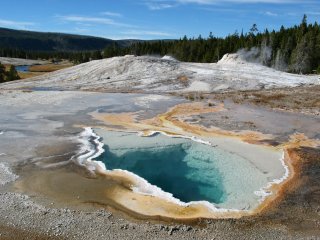
The emerging discipline of astrobiology seeks to understand the origin of life on Earth and the potential for finding life elsewhere in the solar system and beyond. Microbes that thrive under extreme environmental conditions can become fossilized resulting in the preservation of cellular structures or molecules. From the rock record, these biomarkers can help us understand the existence of early microbial life on Earth, how it evolved, and how it influenced biogeochemical cycles. Because extremophiles thrive under extreme temperatures, pH, or salinities, they are analogues of the type of microbial life that could occur on other planets in the solar system, such as Mars. Researchers at Western are active in several areas of astrobiology.
Impact Craters
The destructive effects of impact events have received a great deal of attention since the discovery of the ~180 km diameter Chicxulub impact structure, Mexico, and its link to the Cretaceous–Paleogene mass extinction event ~65 Ma. However, recent and ongoing research suggests that impact events can also produce beneficial effects, particular by providing habitats for microbial life.
Ongoing investigations include:
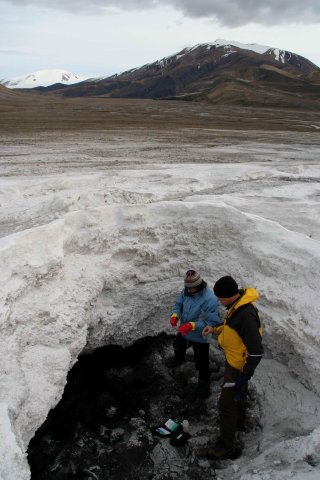
- Impact hydrothermal systems as potential habitats for thermophilic (heat-loving) organisms (Banerjee, Flemming, Osinski).
- The processing of crystalline rocks providing new habitats for endolithic organisms (Osinski).
- Weathering of impact hydrothermal deposits (Banerjee, Flemming, Osinski).
Still interested!? Check out these links for further information on:
- Student positions
- Career opportunities
- The Centre for Planetary Science and Exploration (CPSX)
- The Canadian Lunar Research Network (CLRN)
- NASA Lunar Science Institute
- Geological Association of Canada - Planetary Sciences Division

